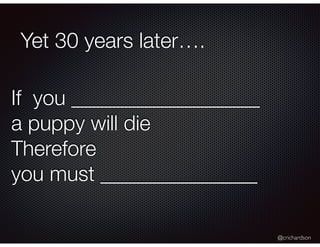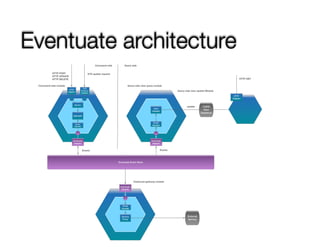Microservices in Java and Scala (sfscala)
- 1. @crichardson Microservices in Java and Scala Chris Richardson Founder of Eventuate.io Founder of the original CloudFoundry.com Author of POJOs in Action @crichardson [email protected] http://microservices.io http://eventuate.io http://plainoldobjects.com Copyright © 2015. Chris Richardson Consulting, Inc. All rights reserved
- 3. @crichardson About Chris Consultant and trainer focusing on microservices (public class: April 28th, Oakland, CA) http://www.chrisrichardson.net/
- 4. @crichardson About Chris Founder of a startup that is creating a platform that makes it easy for application developers write microservices (http://eventuate.io)
- 6. Agenda Why a pattern language for microservices? Monolith architecture vs. microservices Developing microservices with event sourcing and CQRS Microservices in Java Microservices in Scala Example: real-time, collaborative Kanban board application
- 8. @crichardson Yet 30 years later…. If you __________________ a puppy will die Therefore you must _______________
- 9. @crichardson Quiz - fill in the blanks…. mutate state use monads use objects use functions block a thread use async. make a REST call send a messageuse Spring use ….
- 10. @crichardson How we make decisions Decide using emotions Rationalize with our intellect http://en.wikipedia.org/wiki/Mahout
- 11. @crichardson The structure of a pattern = Great framework for discussing and thinking about technology
- 12. @crichardson The structure of a pattern Resulting context aka the situation Name Context Problem Related patterns (conflicting) issues etc to address Forces Solution
- 13. @crichardson
- 14. Agenda Why a pattern language for microservices? Monolith architecture vs. microservices Developing microservices with event sourcing and CQRS Microservices in Java Microservices in Scala Example: real-time, collaborative Kanban board application
- 15. @crichardson
- 16. In theory: We can build a modular monolith But in practice: We build a big ball of mud
- 17. Microservices are not a silver bullet but …
- 18. @crichardson The benefits typically outweigh the drawbacks for large, complex applications
- 19. @crichardson Build and deliver better software faster
- 20. @crichardson Easily try other technologies ... and fail safely
- 21. Agenda Why a pattern language for microservices? Monolith architecture vs. microservices Developing microservices with event sourcing and CQRS Microservices in Java Microservices in Scala Example: real-time, collaborative Kanban board application
- 22. Data management patterns Database per Service Event-driven architecture Shared database Event sourcing Transaction log tailing Database triggers Application events CQRS Database architecture
- 23. Database per Service Orders Service Customer Service Order Database Customer Database Sharded SQL NoSQL DB
- 24. @crichardson Customer management How to maintain invariants? Order management Order Service placeOrder() Customer Service updateCreditLimit() Customer creditLimit ... has ordersbelongs toOrder total Invariant: sum(open order.total) <= customer.creditLimit ?
- 26. @crichardson How atomically update database and publish an event Order Service Order Database Message Broker insert Order publish OrderCreatedEvent dual write problem ?
- 28. @crichardson Use event-sourcing Event table Aggregate type Event id Aggregate id Event data Order 902101 …OrderApproved Order 903101 …OrderShipped Event type Order 901101 …OrderCreated
- 29. @crichardson Replay events to recreate state Order state OrderCreated(…) OrderAccepted(…) OrderShipped(…) Events Periodically snapshot to avoid loading all events
- 30. But what about queries?
- 31. @crichardson Command Query Responsibility Segregation (CQRS) Command side Commands Aggregate Event Store Events Query side Queries (Materialized) View Events
- 32. @crichardson Query-side design Event Store Updater View Updater Service Events Reader HTTP GET Request View Query Service View Store e.g. MongoDB Neo4J CloudSearch update query
- 35. Multiple flavors of client frameworks “Traditional Java” mutable object-oriented domain objects https://github.com/cer/event-sourcing-examples/tree/master/ java-spring Functional Scala with immutable domain objects https://github.com/cer/event-sourcing-using-scala-typeclasses Hybrid OO/Functional Scala with immutable domain objects https://github.com/cer/event-sourcing-examples/tree/master/ scala-spring
- 36. Agenda Why a pattern language for microservices? Monolith architecture vs. microservices Developing microservices with event sourcing and CQRS Microservices in Java Microservices in Scala Example: real-time, collaborative Kanban board application
- 38. @crichardson The Customer aggregate creditLimit creditReservations : Map<OrderId, Money> Customer List<Event> process(CreateCustomerCommand cmd) { … } List<Event> process(ReserveCreditCommand cmd) { … } … void apply(CustomerCreatedEvent anEvent) { … } void apply(CreditServedEvent anEvent) { … } … State Behavior
- 39. @crichardson Familiar concepts restructured class Customer { public void reserveCredit( orderId : String, amount : Money) { // verify // update state this.xyz = … } public List<Event> process( ReserveCreditCommand cmd) { // verify … return … new CreditReservedEvent(); } public void apply( CreditReservedEvent event) { // update state this.xyz = event.xyz }
- 42. @crichardson Creating an order save() concisely specifies: 1.Creates Order aggregate 2.Processes command 3.Applies events 4.Persists events
- 43. @crichardson Event handling in Customers 1. Load Customer aggregate 2. Processes command 3. Applies events 4. Persists events Triggers BeanPostProcessor Durable subscription name
- 44. Customer - query side
- 45. @crichardson MongoDB view: customer and their order history { "_id" : "0000014f9a45004b 0a00270000000000", "_class" : "net.chrisrichardson…..views.orderhistory.CustomerView", "version" : NumberLong(5), "orders" : { "0000014f9a450063 0a00270000000000" : { "state" : "APPROVED", "orderId" : "0000014f9a450063 0a00270000000000", "orderTotal" : { "amount" : "1234" } }, "0000014f9a450063 0a00270000000001" : { "state" : "REJECTED", "orderId" : "0000014f9a450063 0a00270000000001", "orderTotal" : { "amount" : "3000" } } }, "name" : "Fred", "creditLimit" : { "amount" : "2000" } } Denormalized = efficient lookup
- 46. @crichardson Query-side event handler that updates customer view
- 47. @crichardson Updating and query view using Spring Data for MongoDB...
- 48. Agenda Why a pattern language for microservices? Monolith architecture vs. microservices Developing microservices with event sourcing and CQRS Microservices in Java Microservices in Scala Example: real-time, collaborative Kanban board application
- 49. @crichardson Functional Customer aggregate Customer creditLimit creditReservations … CustomerAggregate processCommand(Account, Command) : Seq[Events] applyEvent(Account, Event) : Account Immutable state Behavior
- 50. @crichardson Aggregate type classes Used by Event Store to reconstitute aggregates Hardwired
- 54. Agenda Why a pattern language for microservices? Monolith architecture vs. microservices Developing microservices with event sourcing and CQRS Microservices in Java Microservices in Scala Example: real-time, collaborative Kanban board application
- 56. @crichardson Architecture Create/update boards and tasks Change notifications Materialized views Event Store
- 58. Summary Microservices are not a silver bullet but they are the best choice for large/complex applications Use an event-driven microservices architecture Build services using event sourcing + CQRS Using a language/framework specific programming model

















































![@crichardson
Functional Customer
aggregate
Customer
creditLimit
creditReservations
…
CustomerAggregate
processCommand(Account, Command) :
Seq[Events]
applyEvent(Account, Event) : Account
Immutable
state Behavior](https://image.slidesharecdn.com/microservicessfscala2016-160318160326/85/Microservices-in-Java-and-Scala-sfscala-49-320.jpg)









